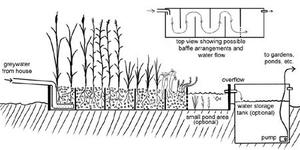WaterBolstering water security in a crowded world
With limited water and the increasing number of people depending on it – there will be more than nine billion people on the planet by 2050 — water security is tenuous. Integrated water management plans using “blue,” “green,” and “gray” water, however, can increase water security by allowing agriculture to rise to the challenge of feeding a growing world population while leaving enough water for other uses.

Schenmatic of system for reclaiming grey water for irrigation // Source: wordpress.com
Agriculture is one of the most insatiable consumers of dwindling water resources around the world. Food production will need to increase by about 70 percent over the next thirty-five years to meet the needs of a growing population. Crops are not creating the only demands; agriculture will face competition for water from cities, industries, and recreation.
With limited water and the increasing number of people depending on it, water security is tenuous. Integrated water management plans using “blue,” “green,” and “gray” water, however, can increase water security. What do these colors mean and why are these waters vital?
An American Society of Agronomy reports that those are the central questions behind the symposium “Blue Waves, Green Dreams, and Shades of Gray: Perspectives On Water” being held Tuesday, 5 November, at 1:15 PM. The symposium is part of the American Society of Agronomy, Crop Science Society of America, and Soil Science Society of America Annual Meetings, 3-6 November, in Tampa, Florida. The theme of this year’s conference is “Water, Food, Energy, & Innovation for a Sustainable World.”
Blue water is found in lakes, rivers, reservoirs, or aquifers. It is used for many purposes such as drinking water, water for homes and businesses, and irrigation water for agriculture.
Freshwater stores are limited, and what’s left of blue water must be protected and used sparingly.
Green water is the water available in the soil for plants and soil microorganisms. It can be absorbed by roots, used by the plants to grow, and released back to the atmosphere. The use of green water by crops must be optimized better to utilize this often overlooked resource.
Gray water is water that has been previously used and may contain some impurities. It can come from cities, households, or industries, and it is waste water that is usually treated and discharged. The reuse of gray water for agriculture can decrease the amount of blue water withdrawn from stores and increase the green water available for plants to use.
These three water sources — blue, gray, and green — have to be protected and optimized if agriculture is to rise to the challenge of feeding more than nine billion people by 2050 while leaving enough water for other uses. After all, says Rattan Lal, presider of the symposium, “There is no substitute for water.”
